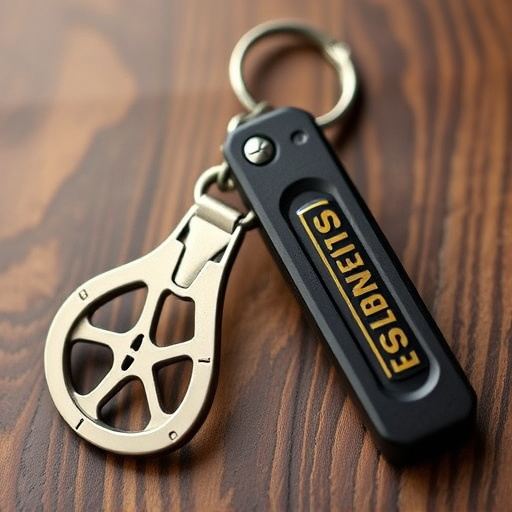University Approved Safety Keychains are crucial for campus security, combining robust materials and specific design features like pocket clips for easy access and discreet self-defense. These keychains must meet institutional requirements for restricted access control and emergency response, holding IDs, keys, and contact info. The pocket clip is engineered for durability, strength, and low-profile aesthetics, enabling users to securely attach their keychain weapons to pockets or bags for quick deployment in potentially high-risk situations.
“Unveiling the innovative world of self-defense, this article explores the art of concealing weapons with a focus on university-approved safety keychain designs. We delve into the crucial balance between discretion and accessibility, guiding you through key considerations for efficient weapon concealment. From material choices to pocket clip integration, learn how these subtle yet powerful tools cater to modern needs while adhering to safety standards. Discover the perfect blend of functionality and secrecy with University Approved Safety Keychains.”
- Understanding University Approved Safety Keychain Requirements
- Design Considerations for Efficient Weapon Concealment
- Material and Crafting Techniques for Durability and Discretion
- Pocket Clip Integration: Enhancing Accessibility and Security
Understanding University Approved Safety Keychain Requirements
University-approved safety keychains are a critical component for students, faculty, and staff ensuring personal security on campus. These requirements vary across institutions but generally focus on preventing unauthorized access to restricted areas and promoting quick response during emergencies. Keychain designs should incorporate robust materials that withstand daily use while adhering to specific size and functionality criteria. The pocket clip is a key feature, allowing easy accessibility without sacrificing discretion.
When considering university-approved safety keychains with pocket clips, it’s essential to balance concealment, comfort, and reliability. A well-designed clip should securely attach to pockets or bags yet allow for effortless removal. Additionally, the keychain should be capable of holding necessary identification cards, access keys, or emergency contact information, ensuring individuals can quickly present these items when required.
Design Considerations for Efficient Weapon Concealment
When designing a keychain weapon concealment pocket clip, safety and practicality must be the primary focus, especially considering university approved use. The key to efficient weapon concealment lies in a well-thought-out design that balances discretion with accessibility. The clip should seamlessly integrate with everyday carry items like keychains or wallets, ensuring it remains hidden from casual glance yet easily retrievable when needed.
Material choice is crucial; lightweight yet durable options like stainless steel or high-quality aluminum offer the best of both worlds. Ergonomic shapes and smooth edges enhance comfort during prolonged wear, while tactical features such as a strong spring load and adjustable clamping mechanisms provide added security and control. In the context of university approved safety keychains, these design considerations are essential to ensure legal carry and personal protection without drawing undue attention.
Material and Crafting Techniques for Durability and Discretion
When designing a keychain weapon concealment pocket clip, material selection and crafting techniques are paramount for both durability and discretion. High-quality materials like steel or titanium offer superior strength and longevity, ensuring the device can withstand daily wear and rugged conditions. These metals also provide a sleek, non-reflective finish that aids in maintaining a low profile, making it ideal for discreet carry—a key feature for University Approved Safety Keychains aimed at enhancing personal security without drawing unwanted attention.
Crafting techniques play an equally vital role. Precision engineering ensures smooth operation and reliable functionality. The use of specialized heat treatment processes hardens the metal, preventing damage or deformation over time. Additionally, laser engraving or subtle texturing can be incorporated to enhance grip without sacrificing a minimalist aesthetic, catering to users seeking both discretion and control.
Pocket Clip Integration: Enhancing Accessibility and Security
The integration of a pocket clip design into keychain weapon concealment offers significant advantages in terms of accessibility and security. This feature allows users to securely attach their self-defense tool to their belt loop, back pocket, or bag, ensuring it’s always within reach. In situations where quick access is crucial—whether for personal safety on campus or while traveling—a well-designed pocket clip can make all the difference.
For students attending universities with strict safety protocols, University Approved Safety Keychains equipped with robust pocket clips provide peace of mind. This integration not only facilitates swift deployment but also adds a layer of discreet security, allowing individuals to protect themselves in potential high-risk environments without drawing unwanted attention.
In conclusion, designing a University-approved safety keychain with weapon concealment capabilities requires careful consideration of both functionality and discretion. By adhering to relevant regulations and utilizing innovative pocket clip integration, it’s possible to create a compact, accessible, and secure solution for personal safety. Durable materials and precise craftsmanship ensure reliability, making this an ideal choice for those seeking a discreet self-defense option while maintaining compliance with campus safety standards.
